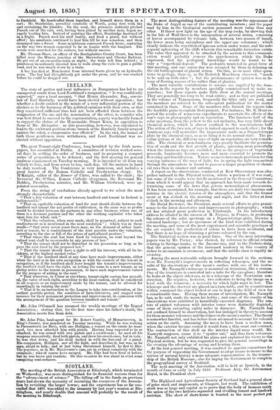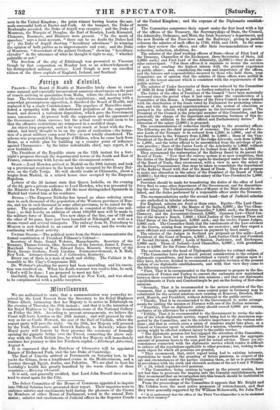SCOTLAND.
The meeting of the British Association at Edinburgh, which terminated on 'Wednesday, was more distinguished for its financial success than for the "advancement of science." The falling-off in the funds on previous years had shown the necessity of recruiting the resources of the Associa- tion by revisiting the larger towns; and the experiment has so far suc- ceeded that 4004 was added to the treasury by last year's session at Bir- mingham, and nearly double that amount will probably be the result of the meeting in Edinburgh. The most distinguishing feature of the meeting was the appearance of the Duke of Argyll as one of the contributing members ; and the paper read by him in the Geological section possessed more value than any other. It threw new light on the age of the trap rocks, by showing that in the Isle of Mull there is the interposition of several strata, consisting of leaves accompanied by volcanic tufa, between two masses of basalt, the lower mass being amorphous and the upper one columnar ; which clearly indicate the repetition of igneous action under water, and the sub- sequent uphoaving of the cliffs wherein this remarkable formation exists. The value that appeared to be attached by the section to this communi- cation would probably remove the apprehension which the Duke expressed, that his geological knowledge would be found to be only a "superficial deposit. The geologists mustered in great force at this meeting, and one entire day was occupied by them in debating on the old battle-ground of glacial action. On this, as on most other Rues.. tions in geology, there is, as Sir Roderick Murchison observed, "much to be said on both sides " ; but the predominance of opinion was in fa- vour of floating masses of ice rather than of glaciers.
The most valuable contributions to science are supplied by the Asso- ciation in the reports by members specially commissioned to make re- searches ; but those reports make little show at the annual meetings. They are generally too long to be read entire and as they are published in the volume of Transactions, frequently the titles only are read, and the members are referred to the subsequent publication for the matter contained in them. Sonic of the members who furnish the reports take the laudable pains to explain their purport. For instance, Mr. R. Hunt re- ported the results of numerous experiments to ascertain the effects of the sun's rays in photography and on vegetation. The luminous half of the solar spectrum, from the yellow to the red inclusive, has very little direct chemical action, which is almost confined to the non-luminous half. The action of the two sets of rays is indeed opposed to each other ; for the luminous rays will neutralize the impressions made on a Daguerreotype plate by the chemical rays, so as to bring it to its normal state. The pe- culiar actions of the different rays of light on vegetation are very remark., able. The chemical or non-luminous rays greatly facilitate the germina- tion of seeds and the first growth of plants, operating most powerfully when the luminous rays are excluded ; but as the progress of vegetation proceeds, luminosity becomes more and more essential to promote the flowering and fructification. Nature seems to have made proyision for this varying influence of the rays of light, for in spring the light transmitted- through the atmosphere is found to possess a larger proportion of chemi- cal rays than in summer and autumn. A report on the observations conducted at Kew Observatory was alto- gether unheard in the Physical section, where a portion of it was read; but some of the results were briefly mentioned in the General Committee; - from which it would appear that an approach has been made towards de- termining some of the laws that govern meteorological phamomena. It has been ascertained, for example, that there are daily two maxima and minima in the electric tension of the atmosphere, and that the former occur at ten o'clock in the morning and night, and the latter at four o'clock in the morning and afternoon.
Sir David Brewster, the President, made several efforts to give promi- nence to the latest discoveries and improvements in photography ; which art has attained great perfection in Edinburgh. In his introductory address he alluded to the success of M. Niepse,e, in France, in producing the colours of the solar spectrum on a Daguerreotype plate, likewise a coloured landscape ; but no specimens of the kind were exhibited during the meeting, and some of the most experienced and scientific practisers of the art consider the production of colour to have been accidental, and that there is no hope of ob0Ming a picture coloured by the sun. The Statistical section was in great force. One of the most interesting papers was by Mr. Porter ; who showed, by reference to official returns relating to Savings-banks, to the Income-tax, and to the Probate-duty, that the general opinion of the increased tendency in this country ef riches to accumulate is erroneous, and that the middle class is rapidly in- creasing. Among the most noticeable subjects brought forward in the sections, were Mr. Nasmyth's improvements in reflecting telescopes, and the re- sults of his observations of the moon's surface with one of his instru- ments. Mr. Nasmyth's telescope is mounted on trunnions, like a cannon. One of the trunnions is converted into a tube for the eyeglass; therefore he looks at the object sideways, as in a telescope of the Newtonian con- struction. He requires, however, two reflectors to bring the image on a level with the trunnion; a necessity by which light must he lost. The telescope and the observer are placed on a turn-table, and by a contrivance within command the object looked at can be kept in the field of view for a considerable time. Having these means of investigation, Mr. Nasmyth has, as he said, made the moon his hobby ; and some of the resulta of hie observations were exhibited in beautifully-executed diagrams. The cra- ters of extinct volcanoes with interior cones were distinctly depicted; some of them extending eighty miles in diameter. Mr. Nasmyth lute not confined himself to observation, but has indulged in theory to account for these monster volcanoes and the ridges on the moon's surface. The theory is somewhat fanciful, and has before been advanced to amount for volcanic action on the earth. Assuming the moon to have been a molten mass, when the exterior became cooled it would form a thin crust and contract. The contraction of this shell on the interior liquid mass would, Mr. Nasmyth supposes, cause it to "sputter out," and thus form volcanoes. Mr. Nasmyth not only exhibited his plans and explained his views to the Physical section, but he was requested to give the general assemblage ha the evening the advantage of seeing and hearing them. At the last general meeting, it was resolved to appoint comaaittees for the purpose of requesting the Government to adopt means to insure to tho science of natural history a more adequate representation in the trustee- ship of the British Museum; also for urging the Government to complete the geographical survey of Scotland. The neat meeting of the Association will be held at Ipswich, in the month of June or early in July 1860. Professor Airy, the Astronomer Royal, is the President elect.
The Highland and Agricultural Society of Scotland had a general show of prize stock and implements, at Glasgow, last week. The exhibition of stock was so large and capital as to prove ;hat the body of farmers ratify the union of the two hitherto separated and rivalling tenant and landlord societies. The show of short-horns is boasted as the most perfect yet
seen in the United Kingdom ; the prize winner having beaten the ani- mals successful both at Exeter and Cork. At the banquet, the Duke of Roxburghe presided, the Duke of Argyll was croupier ; and the Duke of Montrose, the Marquis of Douglas, the Earl, of Rosalyn, Lords Kinnaird,
Clements, Rossmore and Blantyre were present In the merit of speeches," says a local account, there can be no doubt the Dukes had it"; the Duke of Argyll showing "hereditary adroitness" in winning the opinion of both parties as to improvements and rent ; and the Duke of Montrose, "descendant of the gallant Graham," showing "hereditary chivalry" in the utterance of what he thought it right to say, "whether palatable or not."
The freedom of the city of Edinburgh was presented to Viscount Gough by that corporation on Monday last, as an acknowledgment of his distinguished military services. Lord Gough is now an enrolled citizen of the three capitals of England, Ireland, and Scotland.



























 Previous page
Previous page